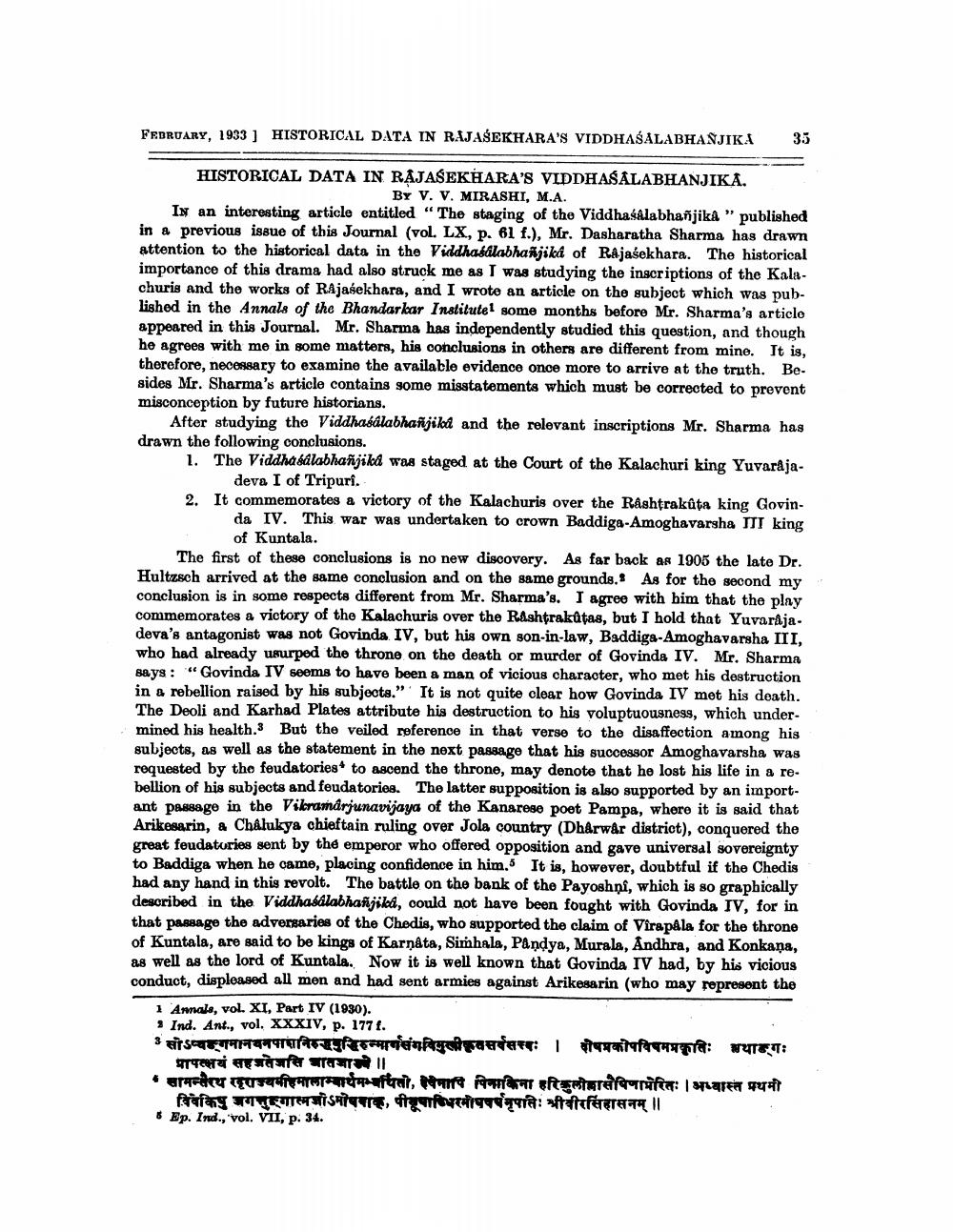________________
FEDRUARY, 1933 ] HISTORICAL DATA IN RAJASEKHARA'S VIDDHAŠALABHANJIKA
35
HISTORICAL DATA IN RAJASEKHARA'S VIDDHASALABHANJIKA.
BY V. V. MIRASHI, M.A. In an interesting article entitled "The staging of the ViddhasAlabhañjika " published in a previous issue of this Journal (vol. LX, p. 61 f.), Mr. Dasharatha Sharma has drawn attention to the historical data in the Viddhatdlabhanjika of Rajasekhara. The historical importance of this drama had also struck me as I was studying the inscriptions of the Kalachuris and the works of RAjasekhara, and I wrote an article on the subject which was published in the Annals of the Bhandarkar Institutel some months before Mr. Sharma's article appeared in this Journal. Mr. Sharma has independently studied this question, and though he agrees with me in some matters, his conclusions in others are different from mine. It is, therefore, necessary to examine the available evidence once more to arrive at the truth. Be. sides Mr. Sharma's article contains some misstatements which must be corrected to prevent misconception by future historians.
After studying the Viddhaéalabhañjika and the relevant inscriptions Mr. Sharma has drawn the following conclusions. 1. The Viddhasálabhañjikd was staged at the Court of the Kalachuri king Yuvaraja
deva I of Tripuri. 2. It commemorates a victory of the Kalachuris over the Rashtrakůta king Govin
da IV. This war was undertaken to crown Baddiga-Amoghavarsha TTT king
of Kuntala. The first of these conclusions is no new discovery. As far back as 1905 the late Dr. Hultzsch arrived at the same conclusion and on the same grounds. As for the second my conclusion is in some respects different from Mr. Sharma's. I agree with him that the play commemorates a victory of the Kalachuris over the Rashtrakūtas, but I hold that YuvarAja. deva's antagonist was not Govinda IV, but his own son-in-law, Baddiga-Amoghavarsha III. who had already usurped the throne on the death or murder of Govinda IV. Mr. Sharma says: "Govinda IV seems to have been a man of vicious character, who met his destruction in & rebellion raised by his subjects." It is not quite clear how Govinda IV met his death. The Deoli and Karhad Plates attribute his destruction to his voluptuousness, which undermined his health. But the veiled reference in that verse to the disaffection among his subjects, as well as the statement in the next passage that his successor Amoghavarsha was requested by the feudatories to ascend the throne, may denote that he lost his life in a rebellion of his subjects and feudatories. The latter supposition is also supported by an important passage in the Vikramarjunavijaya of the Kanarese poet Pampa, where it is said that Arikesarin, a Chalukya chieftain ruling over Jola country (Dharwår district), conquered the great feudatories sent by the emperor who offered opposition and gave universal sovereignty to Baddiga when he came, placing confidence in him. It is, however, doubtful if the Chedis had any hand in this revolt. The battle on the bank of the Payoshni, which is so graphically described in the Viddhasalabhaħjika, oould not have been fought with Govinda IV, for in that passage the adversaries of the Chedis, who supported the claim of Virapala for the throne of Kuntala, are said to be kings of Karnata, Simhala, Pandya, Murala, Andhra, and Konkana, a well as the lord of Kuntala. Now it is well known that Govinda IV had, by his vicious conduct, displeased all men and had sent armies against Arikesarin (who may represent the
1 Anale, vol. XI, Part IV (1930). 3 Ind. Ant., vol. XXXIV, p. 177 f. सोऽचरणमानवनपावनिम्नरिहन्मार्गसंगविमुखीवसर्वसवः । दोषणकोपविषमप्रकृतिः अथागः
प्रापत्क्षवं सहजतेजसि भातमा॥ •सामन्सरथ राज्यमहिमालाम्बार्थमम्मपितो, नापि पिनाकिना हरिकुलोबासषिणामेरितः अभ्यास्त प्रथमी
विवकिा जगत्गात्मजोऽमोषवाक, पीपाधिरमोषषर्षमृपतिः श्रीवीरसिंहासनम् ।। 6 Ep. Ind., vol. VII, p. 34.




